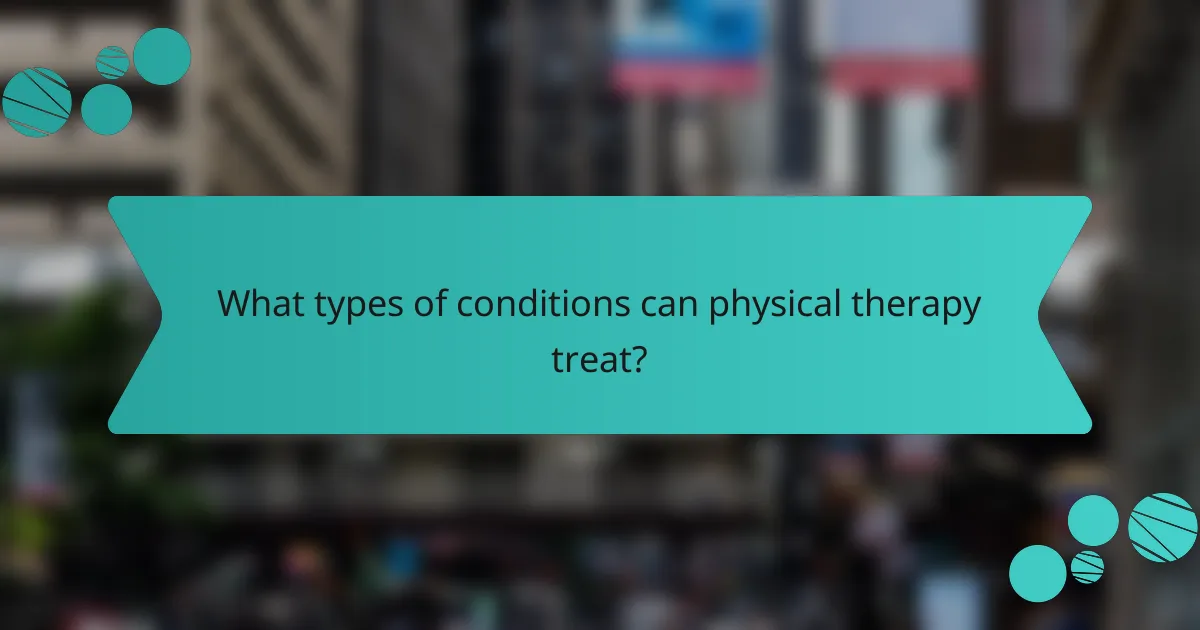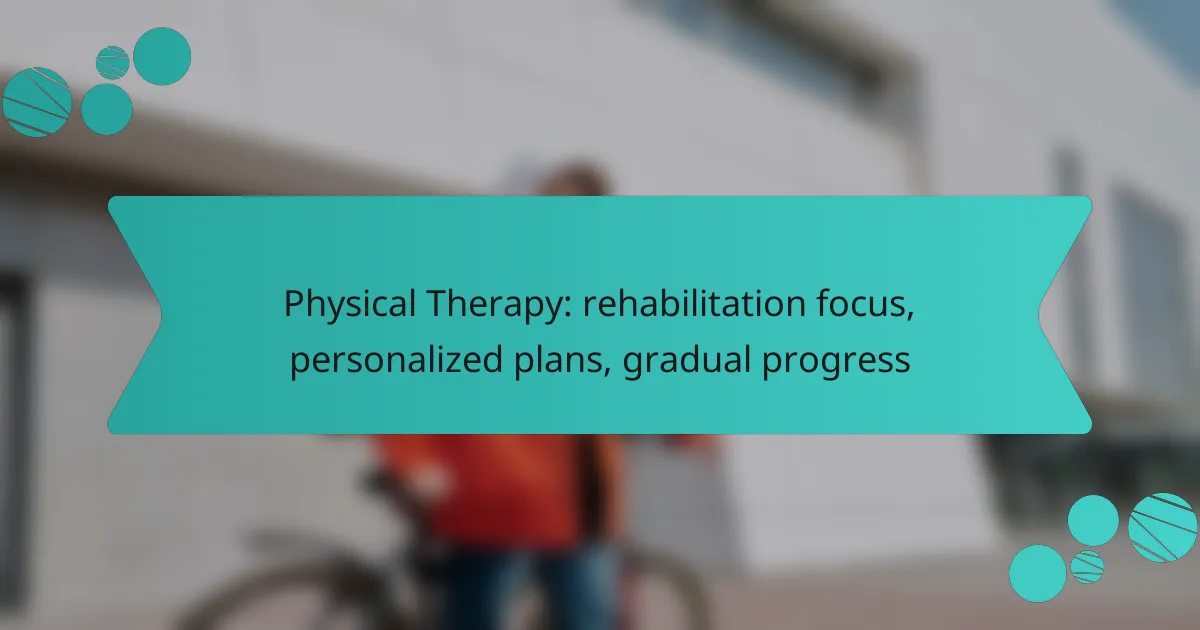Physical therapy plays a crucial role in rehabilitation, offering personalized plans that cater to individual needs and goals. By focusing on gradual progress, these tailored interventions help patients recover from injuries and manage chronic conditions effectively. With a commitment to enhancing mobility and overall health, physical therapy serves as a vital resource for those seeking to regain strength and improve their quality of life.

What are the benefits of physical therapy in Canada?
Physical therapy in Canada offers numerous benefits, including enhanced mobility, effective pain management, and tailored rehabilitation plans. These advantages contribute to improved overall health and quality of life for individuals recovering from injuries or managing chronic conditions.
Improved mobility and function
One of the primary benefits of physical therapy is the enhancement of mobility and functional abilities. Therapists utilize specific exercises and techniques to help patients regain movement and strength, which is crucial for daily activities.
For instance, individuals recovering from surgery or injury may experience limited range of motion. Through targeted physical therapy, they can gradually improve their flexibility and regain the ability to perform tasks such as walking, climbing stairs, or lifting objects.
Pain relief and management
Physical therapy is effective in alleviating pain and managing discomfort associated with various conditions. Therapists employ modalities such as manual therapy, ultrasound, and electrical stimulation to reduce pain levels and promote healing.
Patients often report significant improvements in pain management, allowing them to engage in daily activities with greater ease. Techniques like therapeutic exercises and postural training can also prevent future pain episodes by addressing underlying issues.
Personalized rehabilitation plans
Each physical therapy program in Canada is tailored to meet the unique needs of the individual. Therapists assess each patient’s condition and create a personalized rehabilitation plan that targets specific goals and challenges.
This customized approach ensures that patients receive the most effective treatment for their circumstances, whether they are recovering from an injury, managing a chronic condition, or preparing for surgery. Regular evaluations help adjust the plan as progress is made, ensuring continuous improvement.

How does personalized physical therapy work?
Personalized physical therapy focuses on creating tailored rehabilitation plans that address an individual’s specific needs and goals. This approach ensures that each patient receives targeted interventions designed to promote gradual progress and recovery.
Initial assessment and diagnosis
The process begins with an initial assessment where a physical therapist evaluates the patient’s condition through physical examinations and discussions about their medical history. This diagnosis helps identify the underlying issues that need to be addressed.
During this assessment, therapists may use various tools such as range of motion tests, strength assessments, and functional movement screenings. These evaluations provide a comprehensive understanding of the patient’s physical capabilities and limitations.
Customized treatment plans
Based on the initial assessment, therapists develop customized treatment plans that outline specific goals and the methods to achieve them. These plans may include a combination of exercises, manual therapy, and modalities like ultrasound or electrical stimulation.
Each plan is designed to be flexible, allowing adjustments as the patient progresses. For example, if a patient shows improvement in strength, the therapist may increase the intensity or complexity of exercises to continue challenging them.
Regular progress evaluations
Regular evaluations are crucial to monitor the patient’s progress and the effectiveness of the treatment plan. These assessments typically occur every few weeks and involve re-evaluating the patient’s strength, flexibility, and overall function.
Therapists use these evaluations to determine if the current plan is working or if modifications are necessary. This ongoing feedback loop ensures that the rehabilitation process remains aligned with the patient’s evolving needs and goals, promoting steady improvement over time.

What types of conditions can physical therapy treat?
Physical therapy can effectively treat a wide range of conditions, focusing on rehabilitation and recovery. It is particularly beneficial for musculoskeletal injuries, neurological disorders, and post-surgical rehabilitation, helping patients regain strength and mobility.
Musculoskeletal injuries
Musculoskeletal injuries encompass a variety of issues, including sprains, strains, fractures, and tendonitis. Physical therapy for these conditions often involves a personalized plan that includes exercises to improve strength, flexibility, and range of motion.
Patients may engage in manual therapy techniques, modalities like ultrasound or electrical stimulation, and specific exercises tailored to their injury. Gradual progress is emphasized, with therapists adjusting plans based on individual recovery rates.
Neurological disorders
Neurological disorders such as stroke, multiple sclerosis, and Parkinson’s disease can significantly impact mobility and daily function. Physical therapy aims to enhance motor skills, balance, and coordination through targeted exercises and activities.
Therapists often utilize techniques like gait training and functional mobility exercises to help patients regain independence. Consistent assessment and modifications to the therapy plan ensure that patients are progressing at a suitable pace.
Post-surgical rehabilitation
Post-surgical rehabilitation is crucial for recovery after procedures like joint replacements or ligament repairs. Physical therapy helps restore function and strength while minimizing complications such as stiffness or swelling.
A typical rehabilitation plan may include gradual weight-bearing exercises, stretching, and strengthening activities. Close monitoring by a physical therapist ensures that patients do not push themselves too hard, allowing for optimal healing and recovery.

How to choose a physical therapist in Canada?
Choosing a physical therapist in Canada involves evaluating their qualifications, treatment methods, and patient feedback. This ensures you find a professional who can provide personalized rehabilitation plans tailored to your needs.
Check credentials and experience
Start by verifying the therapist’s credentials, including their education, licensing, and any specialized training. In Canada, physical therapists must be licensed by the regulatory body in their province, which ensures they meet the required standards.
Experience is also crucial; look for therapists who have worked with patients with similar conditions. A therapist with several years of experience may have more effective strategies for rehabilitation.
Read patient reviews
Patient reviews can provide insight into a therapist’s effectiveness and approach. Check online platforms or local health directories for testimonials that highlight the therapist’s strengths and weaknesses.
Look for consistent feedback regarding communication, treatment outcomes, and overall patient satisfaction. This can help you gauge whether the therapist’s style aligns with your expectations.
Evaluate treatment approaches
Different physical therapists may use various treatment methodologies, such as manual therapy, exercise prescription, or modalities like ultrasound. Understanding these approaches can help you select a therapist whose methods resonate with your rehabilitation goals.
Ask potential therapists about their treatment plans and how they tailor them to individual needs. A good therapist will create a personalized plan that promotes gradual progress and addresses your specific challenges.

What is the typical timeline for physical therapy?
The typical timeline for physical therapy varies based on the individual’s condition, goals, and progress, but it generally spans several weeks to months. Most patients can expect to undergo an initial recovery phase, followed by a rehabilitation phase, and finally a maintenance phase to ensure lasting benefits.
Initial recovery phase
The initial recovery phase usually lasts from a few days to several weeks, depending on the injury or surgery. During this time, the focus is on reducing pain and inflammation while restoring basic mobility. Patients may engage in gentle exercises and receive modalities such as ice or heat therapy.
It’s essential to follow the physical therapist’s recommendations closely during this phase to avoid setbacks. Common pitfalls include overexertion and neglecting prescribed rest periods.
Rehabilitation phase
The rehabilitation phase typically spans several weeks to a few months, where the emphasis shifts to rebuilding strength and function. Patients will participate in more intensive exercises tailored to their specific needs, gradually increasing intensity and complexity.
Setting realistic goals is crucial during this phase. Patients should track their progress and communicate any concerns with their therapist to adjust the plan as necessary. A common guideline is to aim for noticeable improvements every few weeks.
Maintenance phase
The maintenance phase can last indefinitely, focusing on sustaining the gains achieved during rehabilitation. Patients are encouraged to continue exercises at home or in a gym setting to prevent regression. This phase may involve less frequent visits to the therapist, transitioning to self-directed programs.
Regular check-ins with a physical therapist can help ensure that exercises remain effective and safe. It’s important to stay consistent with the routine, as neglecting maintenance can lead to a decline in physical capabilities over time.

What are the costs associated with physical therapy?
The costs of physical therapy can vary significantly based on factors like location, type of treatment, and insurance coverage. Generally, patients should expect to pay for individual sessions, which can add up depending on the frequency and duration of therapy needed.
Average session costs in Canada
In Canada, the average cost of a physical therapy session typically ranges from CAD 80 to CAD 150. This price may fluctuate based on the therapist’s experience, the clinic’s location, and the specific services provided during the session.
Patients should also consider additional costs such as assessments, specialized treatments, or equipment. Some clinics offer package deals or discounts for multiple sessions, which can help manage overall expenses.
Insurance coverage can significantly affect out-of-pocket costs. Many health plans include physical therapy benefits, so it’s advisable to check with your provider to understand what is covered and any potential co-pays or deductibles.
